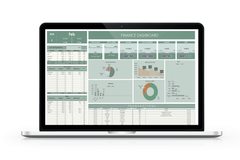Why a “waterfall”? Because money flows best when every £ has a job and moves in a sequence. Do the steps in order so you’re protected first, then efficient, then growing.
Minimum Viable Step (MVS): before you finish reading, set two standing orders: one to your Easy Access buffer, one to Sinking Funds. You can tweak amounts later—ship the system now.
Step 1 — Micro-Buffer (£500–£1,000)
Purpose: Stop small drama (tyres, boiler call-out) from becoming credit-card debt at 25–35% APR.
Where: Easy-access savings with a decent rate. Name it “Emergency Buffer” so you don’t dip into it by accident.
How much:
- Stable job/home: £500–£1,000.
- Variable income/kids/self-employed: lean toward £1,000.
Your tool: Use the Free Savings Distribution Tracker (Google Sheets). Enter “Amount Available to Save”, set a Buffer %, and let it compute the £ per month.
Step 2 — Employer Pension Contributions (the “free return”)
Key idea: If your employer matches part of your contribution (e.g., they add 5% when you add 5%), that’s free money. Even if they don’t match, UK pensions still come with tax relief (and often NI savings via salary sacrifice). Both are hard to beat with cash interest.
Auto-enrolment basics (plain English)
- In the UK, most employers must auto-enrol eligible staff into a workplace pension.
- By law, employers must pay at least 3% of qualifying earnings; total going in must be 8% (usually ~3% employer + ~5% employee incl. basic-rate tax relief).
- Matching above 3% (e.g., “we’ll match you up to 5%”) is optional and varies by employer—check your scheme.
Why this step comes right after the micro-buffer
- The buffer stops you raiding your pension because a tyre blew.
- Then you capture any match and tax relief—returns cash accounts can’t replicate.
Tax relief (two common setups)
- Relief at Source (RAS): You pay from net pay; provider adds 20%. Higher/additional-rate taxpayers claim extra via self-assessment.
- Net Pay Arrangement / Salary Sacrifice: Your contribution is taken before tax (and with sacrifice, before NI too). Sacrifice can increase take-home pay for the same pension contribution.
Tip: If your employer offers salary sacrifice, it’s usually the most efficient (you and the employer both save NI; some employers pass part of their NI saving back into your pension).
What to do (fast)
- Ask HR / scheme docs:
- Do you match contributions? Up to what %?
- Is the scheme Relief at Source or Net Pay / Salary Sacrifice?
- Set your contribution to at least the max match if cashflow allows.
- Keep building the rest of the waterfall in cash alongside.

Step 3 — Full Emergency Fund (3–6 months of essentials)
What counts as essentials: rent/mortgage, utilities, food, transport, childcare, minimum debt payments, insurance.
How much:
- Stable job/dual income: 3 months.
- Variable income/single earner/self-employed: 6–12 months.
Where: Easy-access or notice account. Split across providers if you’re nearing protected limits.
Your tool: Keep the Emergency Fund % as a target in the Free Savings Distribution Tracker so you see progress each month.
Step 4 — Sinking Funds (future costs you know are coming)
Examples: car maintenance, home repairs, MOT/road tax, insurance renewals, annual subs, holidays, gifts, “tech replacement”.
Why it works: People budget monthly but spend annually. Sinking funds smooth that spike.
How:
- List the annual amount per category; divide by 12 for monthly target.
- Create named pots (many banks let you nickname sub-accounts).
- Automate small transfers after payday.
Step 5 — Short-Term Goals (≤ 3 years): Keep in Cash
If the money is needed within 3 years (wedding, house deposit, car, course), keep it in cash. Market downturns can last long enough to hurt short-term goals.
Optimise without admin hell:
- Use an Easy Access hub as the “staging” pot.
- Open Regular Savers (5–8% headline) and drip from the hub.
- Consider Fixed-Term Bonds for any money you won’t need inside the term (ladder them—details below).
Step 6 — Longer-Term Investing (3+ years)
Once you’ve done the steps above, use a Stocks & Shares ISA/pension for goals with 3–5+ years horizon. Keep it simple (low-cost diversified funds). Don’t mix emergency money with investments.
If you’re still carrying very high-interest credit-card debt, focus extra cash on debt payoff before aggressive investing. Use the Debt Snowball Calculator to get a timeline and plan.
How to “Rate-Chase” Without Going Mad
Regular Savers: what the headline rate really pays
Regular savers advertise high APRs (e.g., 7%) but you drip money in, so it doesn’t earn 7% for the whole year.
Rule of thumb: effective % ≈ headline % ÷ 2 on the total you pay in.
Example: £300/month into a 7% regular saver
- You deposit £3,600 over 12 months.
- Average balance is ~halfway through the year.
- Effective interest feels like ~3.5–4% of £3,600 = ~£126–£144 (ballpark).
Still worth it? Often yes—especially paired with your hub and standing orders. Just set expectations right.
Fixed-Rate Bonds (1–2 years): ladder them
- Split money into tranches (e.g., three 1-year bonds, opened four months apart).
- You get rolling liquidity without sacrificing all the rate to easy access.
Premium Bonds (NS&I)
- Capital is safe; prize fund roughly maps to a variable annualised rate, but your personal return isn’t guaranteed. Treat as a “fun” slice, not core emergency cash.
Automation: Make It Move Without You
Hub-and-Spokes setup (rename accounts to match):
-
Hub (Easy Access)
Standing order from your current account on payday (e.g., 30–40% of your saveable amount). - Spokes (automated out of the hub):
- Regular Saver A (e.g., £X/mo)
- Sinking Funds (split across named pots)
- Big Goal (house deposit, course)
- Weekly sweep: If Hub > target, sweep excess to best rate (or to invest, if you’re past Step 6).
Your tools to keep this visible:
-
Free Savings Distribution Tracker — set Target % for each bucket; it computes £ and charts.
-
One-Tab Monthly Budget & Expense Tracker — one screen to set caps, log spending, and see totals.
-
Best Savings Accounts (UK, Aug 2025) — use this to pick your Hub, Regular Saver, and Fixed Bond.
Behaviour Upgrades (the boring bits that win)
- Save the raise: when income goes up, increase your savings % the same day.
- Name the money: “Emergency”, “Car”, “Travel June” beats “Savings 1/2/3”.
- Friction on spending: 24-hour rule on wants > £100.
- Visible progress: charts = dopamine. Keep them front and centre.
- Fun line is mandatory: a small, explicit fun budget prevents sabotage later.
Worked Examples (so the numbers click)
Example A — “I’ve got £300/month spare”
- Buffer (until £1,000): 20% (£60)
- Regular Saver: 40% (£120)
- Sinking Funds: 30% (£90)
- Fun: 10% (£30)
Example B — “£2,000 lump sum”
- Top up buffer to target; split remainder:
- 60% 1-year fixed bond
- 40% Easy Access (to feed Regular Saver monthly)
Example C — “Irregular income”
- Pick a base monthly save (e.g., £100).
- Add a Friday sweep: anything above £X in current → move to Hub.
Deep Dive: Workplace Pensions (the bits most people ignore)
1) Eligibility & opting out
- Most employees aged 22–State Pension age, earning over a threshold, must be auto-enrolled. You can opt out, but you’ll lose employer money and tax relief. If cashflow is tight, contribute something to capture any match, and build the cash waterfall alongside.
2) Qualifying earnings (why your % isn’t on your whole salary)
- The 8% minimum is calculated on earnings between lower and upper thresholds (set by the government). Some employers calculate on total salary (better). Read your scheme.
3) Relief at Source vs Net Pay vs Salary Sacrifice
- Relief at Source: You pay £80; provider adds £20 = £100 in your pot. Higher-rate taxpayers claim extra relief via self-assessment.
- Net Pay: Your contribution is taken before tax; you get full relief automatically (but very low earners can miss out on basic relief—ask HR).
- Salary Sacrifice: You agree to a lower gross salary; employer contributes instead. You save income tax + NI, employer saves NI too (some pass savings on). Can impact things calculated off gross salary (e.g., life cover multiples, mortgage affordability calculations, statutory payments). Check details.
4) “Matching” vs “Statutory”
- Statutory minimum: employer ~3% (on qualifying earnings), total 8%.
- Matching: e.g., “we’ll match up to 5%” → if you pay 5%, they add 5%. Always grab the full match if you can.
5) Why pensions belong early in the waterfall
- Return: match + tax relief often beats chasing an extra 0.25% on savings.
- Lock: It’s long-term. That’s why you build a cash buffer first—so you’re not forced to borrow if something breaks.
Common Failure Modes (and the fix)
-
Chasing every headline rate → you never automate.
Fix: pick a top-tier hub + one regular saver; set orders; move on. -
One giant pot called “savings” → accidental spending.
Fix: named pots and the Distribution Tracker. -
No “fun” budget → rebellion later.
Fix: 5–10% fun line, on purpose. -
Ignoring employer benefits → leaving free money on the table.
Fix: read your scheme; set contribution to the max match you can afford. -
Paying 30% APR while hoarding cash → negative spread.
Fix: use the Debt Snowball Calculator; prioritise debt after the micro-buffer.
Your 30-Minute Action Plan (do it now)
- Open the Free Savings Distribution Tracker → enter Amount Available to Save → set target % for Buffer, Sinking, Goal, Fun.
- Create/rename your accounts: Hub, Emergency, Sinking pots, Goal.
- Standing orders:
- Current → Hub (the total save amount) on payday.
- Hub → Regular Saver £X/month.
- Hub → Sinking Funds £Y split across pots.
4. Ask HR: Do you match up to X%? Is it salary sacrifice? Set your pension % accordingly.
5. Open one Fixed-Term Bond (if suitable) for a slice you won’t need for 12 months.
6. Add a weekly sweep: anything above target in Hub → move to best rate (or to invest if you’ve passed Step 6).
7. Track with the One-Tab Monthly Budget & Expense Tracker so you actually see month-end totals and stop guessing.
FAQs
-
Should I invest before a full emergency fund?
Generally no. Build the buffer first so you don’t sell investments in a downturn to fix a boiler. -
Is a 7% regular saver “better” than a 5% fixed bond?
For steady contributions, a 7% regular saver’s effective return on your total yearly deposits is closer to ~3.5–4%. A 5% fixed bond on a lump sum is a true 5% on the full amount. Use both: bond for lump sums, regular saver for monthly cashflow. -
How big should my emergency fund be?
3–6 months of essentials. Err higher if income is variable. Start with £500–£1,000 so you’re protected quickly. -
What if I’m self-employed?
Go heavier on cash buffers (6–12 months), consider pension contributions for tax relief, and automate transfers the day your invoices land.
Final word
You don’t need a complicated plan. You need the right order and automation so it happens even on busy weeks. Do the waterfall in order, name the pots, and let standing orders run your plan.
Plan & split: Free Savings Distribution Tracker
Control the month: One-Tab Monthly Budget & Expense Tracker
Pick accounts: Best Savings Accounts (UK, Aug 2025)
Debt Calculator Snowball method
MVS (today): set two standing orders (Hub + Sinking). Then message HR about matching. Done.
This is general education, not finacial personla advice. Check your scheme documents and product terms before you move money.






